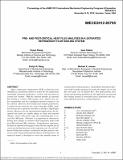| dc.contributor.author | Zhang, TieJun | |
| dc.contributor.author | Catano, Juan | |
| dc.contributor.author | Jensen, Michael K. | |
| dc.contributor.author | Wang, Evelyn | |
| dc.date.accessioned | 2019-01-24T19:02:27Z | |
| dc.date.available | 2019-01-24T19:02:27Z | |
| dc.date.issued | 2012-11 | |
| dc.identifier.isbn | 978-0-7918-4523-3 | |
| dc.identifier.uri | http://hdl.handle.net/1721.1/120129 | |
| dc.description.abstract | Vapor compression refrigeration (VCR) cooling has been identified as a promising solution to ensure the low-Temperature sustainable operation of photonics, avionics and electronics in extreme hot weather. With the inherent benefits of saturated flow boiling in a direct VCR cooling cycle, uniform low surface temperature and low solid/liquid thermal resistances can be achieved. However, flow boiling heat transfer performance is limited by the relatively low critical heat flux (CHF) condition because the evaporator inlet flow is already a liquid/vapor mixture. Moreover, for the aforementioned applications, the dissipated heat loads are usually subject to large and transient changes, which could easily cause the evaporating flow to exceed the CHF point. Therefore, it is important to characterize boiling heat transfer in transient VCR evaporators under both pre-CHF and post-CHF conditions. Comprehensive experimental data are reported in this paper to describe the complete forced convection boiling hysteresis at the evaporator exit. Several wellknown boiling heat transfer correlations and flow pattern criteria are used to help understand the physics of the hysteresis. An empirical model is developed to reveal the unstable nature of transition flow boiling dynamics. A probability distribution function model is further proposed to predict the droplet size in mist flow and vapor core of annular flow. This study provides more design and operating guidelines for the application of saturated flow boiling systems in renewable power generation and electronics/ photonics/avionics cooling industries. Topics: Flow (Dynamics), Boiling, Refrigerants, Heat flux | en_US |
| dc.publisher | ASME International | en_US |
| dc.relation.isversionof | http://dx.doi.org/10.1115/IMECE2012-85795 | en_US |
| dc.rights | Article is made available in accordance with the publisher's policy and may be subject to US copyright law. Please refer to the publisher's site for terms of use. | en_US |
| dc.source | ASME | en_US |
| dc.title | Pre- and Post-Critical Heat Flux Analyses in a Saturated Refrigerant Flow Boiling System | en_US |
| dc.type | Article | en_US |
| dc.identifier.citation | Zhang, TieJun, Juan Catano, Evelyn N. Wang, and Michael K. Jensen. “Pre- and Post-Critical Heat Flux Analyses in a Saturated Refrigerant Flow Boiling System.” ASME 2012 International Mechanical Engineering Congress and Exposition, 9-15 November, 2012, Houston, Texas, ASME, 2012. © 2012 by ASME | en_US |
| dc.contributor.department | Massachusetts Institute of Technology. Department of Mechanical Engineering | en_US |
| dc.contributor.mitauthor | Wang, Evelyn | |
| dc.relation.journal | ASME 2012 International Mechanical Engineering Congress and Exposition | en_US |
| dc.eprint.version | Final published version | en_US |
| dc.type.uri | http://purl.org/eprint/type/ConferencePaper | en_US |
| eprint.status | http://purl.org/eprint/status/NonPeerReviewed | en_US |
| dc.date.updated | 2019-01-09T17:54:32Z | |
| dspace.orderedauthors | Zhang, TieJun; Catano, Juan; Wang, Evelyn N.; Jensen, Michael K. | en_US |
| dspace.embargo.terms | N | en_US |
| dc.identifier.orcid | https://orcid.org/0000-0001-7045-1200 | |
| mit.license | PUBLISHER_POLICY | en_US |
